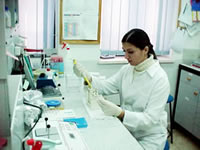“Pharmacogenic gene delivery and gene therapy of Restenosis “

Antisense oligodeoxnucleotides (ODN) are small stretches that have shown the ability to inhibit gene expression. Therefore, they are promising candidates for the treatment of various diseases. However, because of poor stability in biological fluids and weak intracellular penetration their use in living systems is prohibited. Aiming to increase their stability, phosphorothioated ODNs were developed. However, non-sequence specific interactions with cellular proteins and toxicity still remain a major disadvantage for their use. For increasing their uptake ODNs have been covalently conjugated or condensate to cationic peptides, entrapped into pH-sensitive liposomes or cationic lipid-mediators and colloidal no particle.

Our biodegradable, biocompatible poly (DL-lactide-co-glycolide) based sub-micron sustained action formulations would offer efficient intracellular localization and prolonged uptake of antisene ODN. PLGA based double emulsion system and the solvent evaporation techniques were used to incorporate different ODNs. Due to lack of mRNA overlapping, for each of rat PDGFR-ß and human PDGFR-ß two anti-sense along with their scrambled sequences were designed. Fully and partially phosphorothioated ODNs were used in this study. The formulations were prepared and characterized for loading efficiency (80%), sustained release profile (over a month), size and morphology (300 nm). The bioactivity of the encapsulated ODNs was investigated by in-vitro transfection of rat smooth muscle (SMC) and ZnR5 cells (expressing human PDGFR-ß). The biological activity of the ODN-NPs was evaluated by assessment of cell growth inhibition and receptor down regulation.

It is well known that vascular smooth muscle cells (VSMC) proliferation and migration play a major role in neointima formation (i.e. restenosis). Both proliferation and migration of VSMC are induced after percutaneous transluminal coronary angioplasty (PTCA). Recent reports based on in vitro studies and animal models highlight the possible importance of PDGFR-ß/PDGF and avß5 integrals transudation pathways in mediating this process. Preliminary studies in our lab have shown that the PDGFR-ß/PDGF inhibition reduces VSMC proliferation by 35%, however other studies have implicated the OPN/avß3 pathway in VSMC proliferation. In this proposal, a novel delivery technique with antisense oligonucleotides will be utilized for dual inhibition of both the PDGFR-ß/PDGF and the OPN/avß3 pathways. The main goal is to achieve a stable and sustainable VSMC proliferation inhibition. The experimentation in this research will facilitate the understanding of the bimolecular processes involved in neointima formation. It will have great impact on the future designing of new therapies of coronary diseases.


